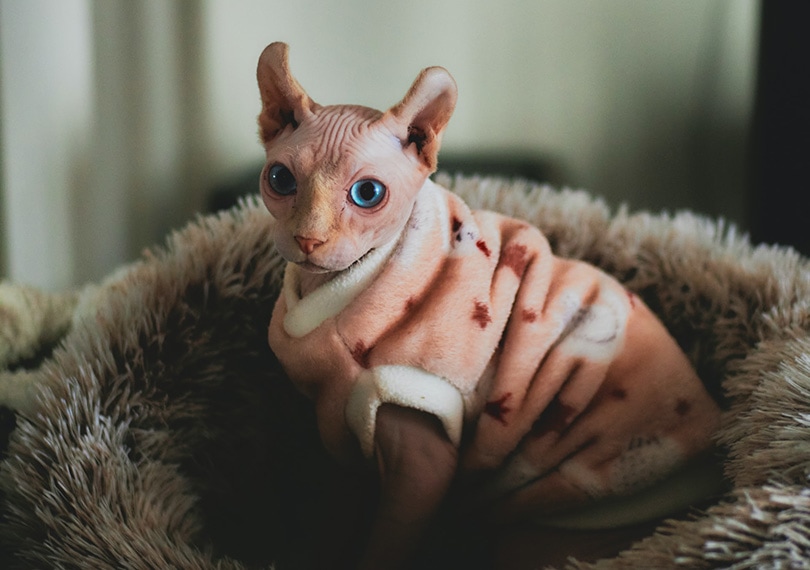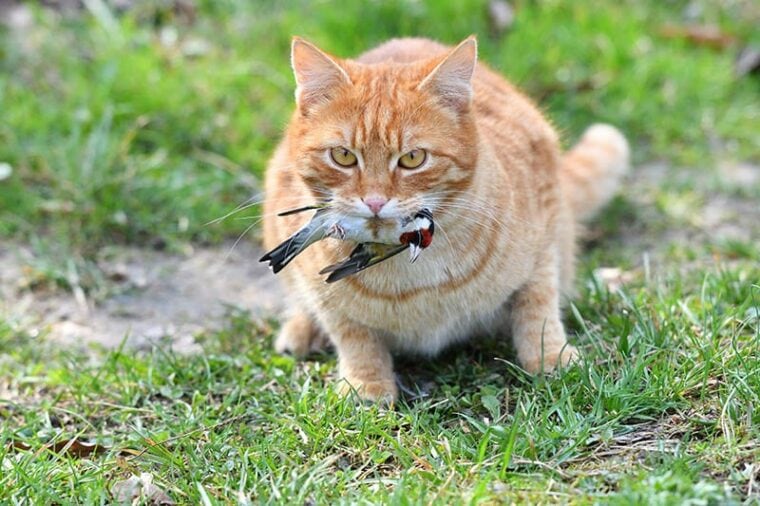
Click to Skip Ahead
Note: This article’s statistics come from third-party sources and do not represent the opinions of this website.
Cats make fantastic pets, but when they’re allowed to free roam outside, they can devastate global diversity. Cats kill countless birds every year worldwide and have even contributed to the extinction of some bird species.
It may be hard to imagine your sweet fur baby turning into a cold-blooded killer, but hunting and killing are practically coded into its DNA. In fact, cats kill up to 350 million birds in Canada alone every year!
If you’re interested in learning more, come along with us as we go through 13 shocking statistics about cat predation on birds in Canada.
The 13 Statistics About How Many Birds Cats Kill in Canada
- Cats kill between 100 and 350 million birds annually in Canada.
- Cats are the number one human-related source of bird deaths in Canada.
- Urban cats account for only one-sixth of bird kills in Canada.
- Cats account for 74% of the mortality for Canadian land birds.
- Cats are responsible for 22% of nest predation events in a protected area in Saanich, B.C.
- Cats bring home less than 25% of their bird kills.
- Parent birds reduced food delivery to their nestlings by more than one-third after seeing a cat nearby.
- Forty-five percent of British Columbians agree that cats are a significant cause of bird mortality.
- Thirty-three percent of Canadians without pets believe that cats are a significant cause of bird mortality.
- Twenty-eight percent of cat owners allow their pets to have unsupervised time outdoors.
- Sixty-six percent of cats are kept from free roaming in Ontario.
- Forty-four species of Canadian forest birds are decreasing in population.
- Twenty-five percent of the bird species that regularly live in Canada are vulnerable to cat predation.
Cat Bird Kills by the Numbers
1. Cats kill between 100 and 350 million birds annually in Canada.
(Blancher)
Predation by cats is one of the biggest human-related sources of mortality for wild birds in North America. Most of the 100 to 350 million bird deaths are likely done by feral cats.
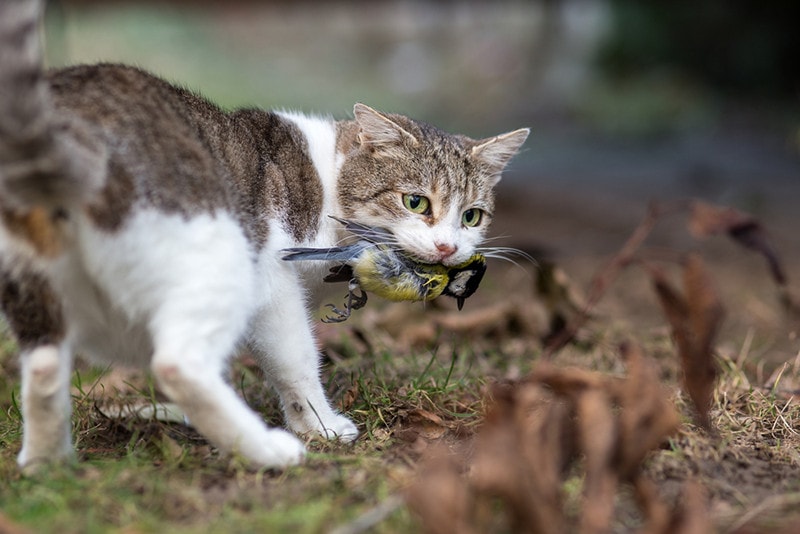
(Stewardship Centre of British Columbia)
Cats are agile and skillful hunters, and this innate knack for hunting is the downfall of many species worldwide, not just birds. Cats are the biggest human-related source of bird deaths in the country. Other significant human-related causes of avian deaths include collisions with vehicles and windows, commercial forestry, offshore oil and gas, and commercial fisheries.
3. Urban cats account for only one-sixth of bird kills in Canada.
(Blancher)
Urban cats account for 53% of the house cats in Canada, but they are only responsible for around one-sixth (17%) of the bird kills. Conversely, feral cats account for just 25% of Canadian cats but are responsible for 59% of the birds killed.
4. Cats account for 74% of the mortality for Canadian land birds.
(Calvert, et al.)
Land birds are the most populous of all the Canadian breeding bird species. Approximately 89% of the birds killed annually by human-related causes are land birds. Cats cause 74% of this mortality.

5. Cats are responsible for 22% of nest predation events in a protected area in Saanich, B.C.
(Rithet’s Bog Conservation Society)
Rithet’s Bog is a conservation area in Saanich, British Columbia. The natural park area and sanctuary have high levels of biodiversity and are home to many species of birds. Unfortunately, outdoor cats, both feral and owned, often visit the area and are responsible for 22% of bird nest predation that occurs there.
6. Cats bring home less than 25% of their bird kills.
(Pearson, et al.)
Most cat owners have no idea what their cats are up to when they’re outside unsupervised. This may be partly due to the fact that less than 25% of birds are brought back home after the cat has killed them.
7. Parent birds reduced food delivery to their nestlings by more than one-third after seeing a cat nearby.
(Pearson, et al.)
It’s not only the act of killing that’s impacting the bird population in Canada. Predator stress can also have a big impact on how birds parent, ultimately affecting their babies. For example, birds with nestlings have been shown to reduce the food they deliver to their babies by more than one-third for over 90 minutes after they spot a cat in the vicinity.
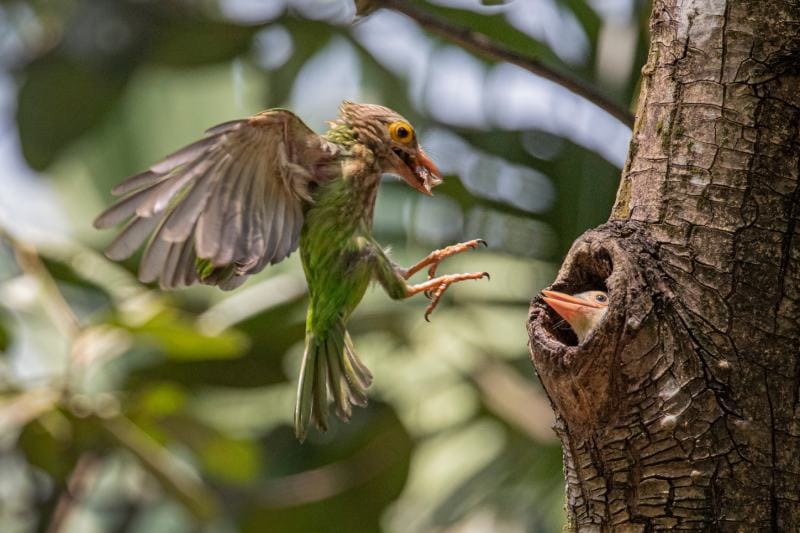
Canadians’ Perception of Cats vs Birds
8. Forty-five percent of British Columbians agree that cats are a significant cause of bird mortality.
(Stewardship Centre for British Columbia)
Cat-owning British Columbians were surveyed so researchers could assess the attitudes and knowledge they had regarding roaming cats. Of the British Columbian cat owners surveyed, 45% agreed or strongly agreed that cats are a significant cause of bird deaths in the province. Approximately 35% of respondents either disagree or strongly disagree with this statement.
9. Thirty-three percent of Canadians without pets believe that cats are a significant cause of bird mortality.
(Stewardship Centre for British Columbia)
The opinions among non-cat-owning British Columbians are more divided. Approximately 34% are neutral on the subject. Thirty-three percent disagreed that birds are a significant cause of bird mortality, and the remaining 33% agreed with the statement.
10. Twenty-eight percent of cat owners allow their pets to have unsupervised time outdoors.
(Humane Canada)
The majority (72%) of cats with owners spend their time indoors or under close supervision outdoors (e.g., with a leash or in a catio). Twenty-eight percent of Canadian cat owners let their cats outside unsupervised.

11. Sixty-six percent of cats are kept from free roaming in Ontario.
(Cats and Birds)
Free-roaming cats are a big part of the problem, and there are significant regional variations in cat owners’ views on the subject. For example, sixty-six percent of Ontario cats are kept from free-roaming, while Quebec’s cats come in a close second at 64%. Conversely, British Columbia cat owners are the most likely population in Canada to allow their pets to roam free (43%).
There are also differences in opinion between generations. Seventy percent of Canadian cat owners between 18 to 29 were the most likely to not allow their cats to free roam. Those in the 30 to 39 age bracket were the least likely at 49%.
The State of Canada’s Birds
12. Forty-four species of Canadian forest birds are decreasing in population.
(NABCI Canada)
Forest birds that breed in Canada and fly south for the winter face many threats during migration, and on the grounds, they choose to winter on. Eighty percent of Canada’s forest birds spend winter outside of the country.
It’s not all bad news. While 44% of Canada’s forest birds are decreasing in numbers, 49% are increasing and 30% are stable.
Canadians can prevent the death of millions of forest birds annually by keeping cats from free-roaming, making windows more visible to birds, and managing light pollution during the migration season.
13. Twenty-five percent of the bird species that regularly live in Canada are vulnerable to cat predation.
(Blancher)
There are approximately 460 bird species that regularly occur in the country. Of these 460 birds, 25% (or 115 species) are considered vulnerable to cat predation. They may be at risk because of their nesting or feeding behaviors, as species that forage in trees versus on the ground were generally not considered vulnerable.
Twenty-three bird species at risk in Canada are among those in danger of cat predation.
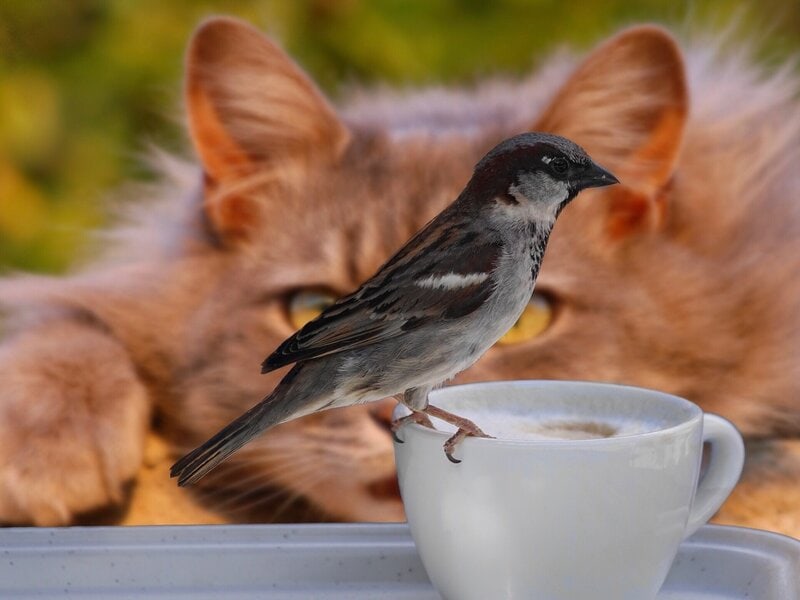
Frequently Asked Questions
Do other countries have the same problem?
Absolutely. One study suggests that domestic cats kill up to four billion birds and 22.3 million mammals annually in the United States alone. Feral cats on islands are responsible for 14% of the global bird, mammal, and reptile extinctions. They’re also the main threat to 8% of critically endangered mammals, birds, and reptiles. (Loss) (Medina, et al.)
Is the cat predation problem really that bad?
Yes. The ecological dangers cats pose to the environment are so critical that the International Union for Conservation of Nature lists cats as one of the 100 worst invasive alien species on earth. Invasive mammals endanger nearly 600 species at risk of extinction, with cats, dogs, rodents, and pigs threatening the most overall. (Doherty, et al.)
How can cat owners prevent their pets from killing birds?
The only foolproof way to prevent a cat from killing a bird is to keep it inside. It cannot kill what it cannot reach. However, keeping it inside might cause issues if you have an outdoor cat. We recommend investing in a catio, leash, and harness so your kitty can enjoy its time outside while keeping the neighborhood birds safe from predation.
It’s not a bad idea to transition your pet to living predominantly indoors, anyway. Outdoor cats live significantly shorter lives, typically around two to five years. (PetMD)
Why do cats kill birds?
Cats are adept hunters, thanks to wild ancestors. They didn’t always have loving humans to provide them with a warm bed and tasty food every day, so they evolved to learn to hunt for themselves. Though your kitty has you to provide for them, that natural inclination to be a predator still remains in its DNA.
Some owners mistakenly think their cats are killing birds and mammals to satisfy their hunger. This isn’t always the case. They have just evolved to hunt whenever they can, whether they’re hungry or not. That way, they know their kill is nearby when it’s time to eat.
Final Thoughts
Cats may be our cute and cuddly fur babies in our homes, but their natural predatory behavior kicks in the moment they see a bird fly by. As a result, cats pose a significant risk to wildlife and global biodiversity. They kill billions of birds yearly and have contributed to the extinction of over 60 species of birds, mammals, and reptiles.
The only way to prevent cats from further decimating bird populations is to keep them inside or only allow them outside when they can be supervised.
Featured Image Credit: Klimek Pavol, Shutterstock




